Mechanochemical Synthesis and Hydrogen Sorption Properties of a V-Ni Alloy
Abstract
1. Introduction
2. Materials and Methods
3. Results and Discussion
3.1. Stoichiometric and Structural Analysis
3.2. Hydrogen Absorption/Desorption
4. Conclusions
Author Contributions
Funding
Data Availability Statement
Conflicts of Interest
References
- Smith, J.F.; Peterson, D.T. The H-V (Hydrogen-Vanadium) System. Bull. Alloy Phase Diagr. 1982, 3, 55–60. [Google Scholar] [CrossRef]
- Ukita, S.; Ohtani, H.; Hasebe, M. Thermodynamic analysis of the V–H binary phase diagram. Mater. Trans. 2008, 49, 2528–2533. [Google Scholar] [CrossRef]
- Griffiths, R.; Pryde, J.A.; Righini-Brand, A. Phase diagram and thermodynamic data for the hydrogen/vanadium system. J. Chem. Soc. Faraday Trans. 1 1972, 68, 2344–2349. [Google Scholar] [CrossRef]
- Otani, N.; Kuwabara, A.; Ogawa, T.; Fisher, C.J.A.; Tanaka, I.; Akiba, E. Equilibrium hydrogen pressures in the V–H system from first principles. Int. J. Hydrogen Energy 2019, 44, 28909–28918. [Google Scholar] [CrossRef]
- Yukawa, H.; Yamashita, D.; Ito, S.; Morinaga, M.; Yamaguchi, S. Alloying effects on the phase stability of hydrides formed in vanadium alloys. Mater. Trans. 2002, 43, 2757–2762. [Google Scholar] [CrossRef][Green Version]
- Liu, Z.; Xiong, L.; Li, J.; Liu, S.; Er, S. Effects of alloying elements (Al, Mn, Ru) on desorption plateau pressures of vanadium hydrides: An experimental and first-principles study. Int. J. Hydrogen Energy 2018, 43, 21441–21450. [Google Scholar] [CrossRef]
- Nakamura, Y.; Akiba, E. Hydriding properties and crystal structure of NaCl-type mono-hydrides formed from Ti–V–Mn BCC solid solutions. J. Alloys Comp. 2002, 345, 175–182. [Google Scholar] [CrossRef]
- Steward, S.A. Review of Hydrogen Isotope Permeability through Metals. U.S. National Laboratory Report: UCRL-53441; Lawrence Livermore National Lab: Livermore, CA, USA, 1983.
- Santucci, A.; Tosti, S.; Basile, A. Chapter 4. Alternatives to palladium in membranes for hydrogen separation: Nickel, niobium and vanadium alloys, ceramic supports for metal alloys and porous glass membranes. In Handbook of Membrane Reactors; Basile, A., Ed.; Woodhead Publishing Series in Energy; Woodhead Publishing: Cornwall, UK, 2013; Volume 1, p. 183e217. ISBN 978-0-85709-414-8. [Google Scholar]
- Ockwig, N.W.; Nenoff, T.M. Membranes for Hydrogen Separation. Chem. Rev. 2007, 107, 4078–4110. [Google Scholar] [CrossRef]
- Tosti, S.; Santucci, A.; Pietropaolo, A.; Brutti, S.; Palumbo, O.; Trequattrini, F.; Paolone, A. Hydrogen sorption properties of V85Ni15. Int. J. Hydrogen Energy 2018, 43, 2817–2822. [Google Scholar] [CrossRef]
- Brutti, S.; Tosti, A.; Santucci, A.; Paolone, A. Deuterium absorption properties of V85Ni15 and evidence of isotope effect. Int. J. Hydrogen Energy 2019, 44, 20145–20149. [Google Scholar] [CrossRef]
- Dunlap, R.A.; Cheng, Z.H.; MacKay, G.R.; O’Brien, J.W.; Small, D.A. Preparation of nanocrystalline metal hydrides by ball milling. Hyperfine Interact. 2000, 130, 109–126. [Google Scholar] [CrossRef]
- Huot, J.; Cuevas, F.; Deledda, S.; Edalati, K.; Filinchuk, Y.; Grosdidier, T.; Hauback, B.C.; Heere, M.; Jensen, T.R.; Latroche, M.; et al. Mechanochemistry of Metal Hydrides: Recent Advances. Materials 2019, 12, 2778. [Google Scholar] [CrossRef] [PubMed]
- Huot, J.; Ravnsbæk, D.B.; Zhang, J.; Cuevas, F.; Latroche, M.; Jensen, T.R. Mechanochemical synthesis of hydrogen storage materials. Prog. Mater. Sci. 2013, 58, 30–75. [Google Scholar] [CrossRef]
- Orimo, S.-I.; Kimmerle, F.; Majer, G. Hydrogen in nanostructured vanadium-hydrogen systems. Phys. Rev. B 2001, 63, 094307. [Google Scholar] [CrossRef]
- Krishnan, V.K.; Sinnaeruvadi, K. Synthesis of nanostructured vanadium powder by high-energy ball milling: X-ray diffraction and high-resolution electron microscopy characterization. Philos. Mag. Lett. 2016, 96, 402–408. [Google Scholar] [CrossRef]
- Huot, J.; Enoki, H.; Akiba, E. Synthesis, phase transformation, and hydrogen storage properties of ball-milled TiV0.9Mn1.1. J. Alloys Compds. 2008, 453, 203–209. [Google Scholar] [CrossRef]
- Lototskyy, M.; Goh, J.; Davids, M.W.; Linkov, V.; Khotseng, L.; Ntsendwana, B.; Denys, R.; Yartys, V.A. Nanostructured hydrogen storage materials prepared by high-energy reactive ball milling of magnesium and ferrovanadium. Int. J. Hydrogen Energy 2019, 44, 6687–6701. [Google Scholar] [CrossRef]
- Zhang, Y.F.; Li, R.R.; Zhao, X.L.; Diao, S.Z.; Liu, P.P.; Wan, F.R.; Zhan, Q. Particle size evolution of V–4Cr–4Ti powders in high energy vibrating and planetary ball milling. Mater. Res. Express 2019, 6, 066535. [Google Scholar] [CrossRef]
- Balcerzak, M. Structure and hydrogen storage properties of mechanically alloyed Ti-V alloys. Int. J. Hydrogen Energy 2017, 42, 23698–23707. [Google Scholar] [CrossRef]
- Toby, H.H.; Von Dreele, R.B. GSAS-II: The genesis of a modern open-source all purpose crystallography software package. J. Appl. Cryst. 2013, 47, 544–549. [Google Scholar] [CrossRef]
- Caravella, A.; Hara, S.; Drioli, E.; Barbieri, G. Sieverts law pressure exponent for hydrogen permeation through Pd-based membranes: Coupled influence of non-ideal diffusion and multicomponent external mass transfer. Int. J. Hydrogen Energy 2013, 38, 16229–16244. [Google Scholar] [CrossRef]
- Sieverts, A. The Absorption of Gases by Metals. Z. Für Met. 1929, 21, 37–46. [Google Scholar]
- Voyt, A.; Sidorov, N.; Sipatov, I.; Dobrotvorskii, M.; Piven, V. Hydrogen solubility in V85Ni15 alloy. Int. J. Hydrogen Energy 2017, 42, 3058–3063. [Google Scholar] [CrossRef]
- Karger, B.L.; Snyder, L.R.; Horvath, C. An Introduction to Separation Science; Wiley: New York, NY, USA, 1973. [Google Scholar]
- Palumbo, O.; Trequattrini, F.; Pal, N.; Hulyalkar, M.; Sarker, S.; Chandra, D.; Flanagan, T.; Dolan, M.; Paolone, A. Hydrogen absorption properties of amorphous (Ni0.6Nb0.4−yTay)100−xZrx membranes. Prog. Nat. Sci. 2017, 27, 126–131. [Google Scholar] [CrossRef]
- Ono, S.; Nomura, K.; Ikeda, Y. The reaction of hydrogen with alloys of vanadium and titanium. J. Less-Common Met. 1980, 72, 159–165. [Google Scholar] [CrossRef]
- Reilly, J.J.; Wiswall, R.H., Jr. The higher hydrides of vanadium and niobium. Inorg. Chem. 1970, 9, 1678–1682. [Google Scholar] [CrossRef]
- Jayalakshmi, S.; Choi, Y.G.; Kim, Y.C.; Kim, Y.B.; Fleury, E. Hydrogenation properties of Ni-Nb-Zr–Ta amorphous ribbons. Intermetallics 2010, 18, 1988–1993. [Google Scholar] [CrossRef]
- Zepon, G.; Hessel Silva, B.; Zlotea, C.; Botta, W.J.; Champion, Y. Thermodynamic modelling of hydrogen-multicomponent alloy systems: Calculating pressure-composition-temperature diagrams. Acta Mater. 2021, 215, 117070. [Google Scholar] [CrossRef]
- Terwey, A.; Gruner, M.E.; Keune, W.; Landers, J.; Salamon, S.; Eggert, B.; Ollefs, K.; Brabänder, V.; Radulov, L.; Skokov, K.; et al. Influence of hydrogenation on the vibrational density of states of magnetocaloric LaFe11.4Si1.6H1.6. Phys. Rev. B 2020, 101, 064415. [Google Scholar] [CrossRef]
- Todorova, S.; Abrashev, B.; Rangelova, V.; Mihaylov, L.; Vassileva, E.; Petrov, K.; Spassov, T. Hydrogen Gas Phase and Electrochemical Hydriding of LaNi5−xMx (M = Sn, Co, Al) Alloys. Materials 2021, 14, 14. [Google Scholar] [CrossRef]
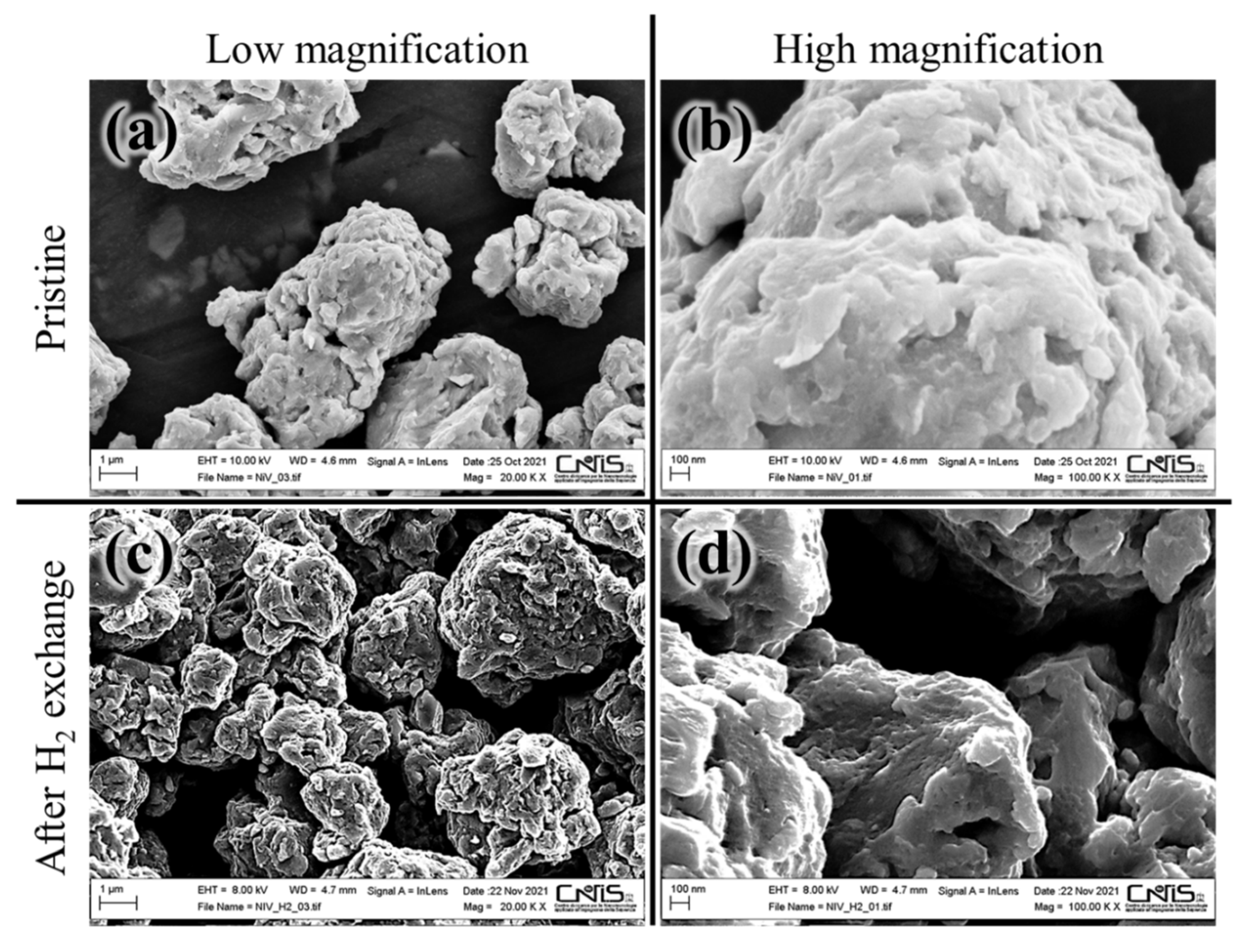
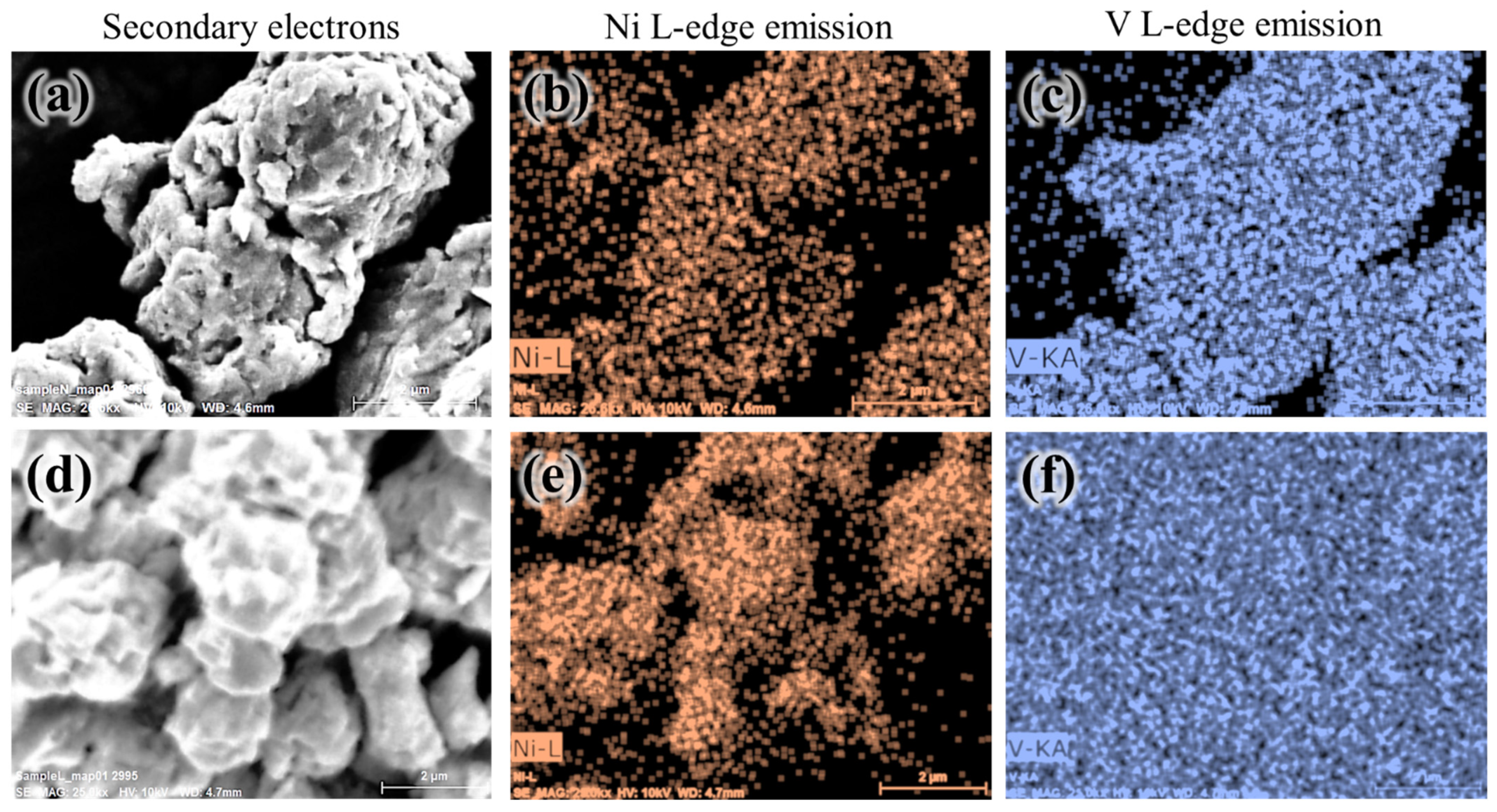

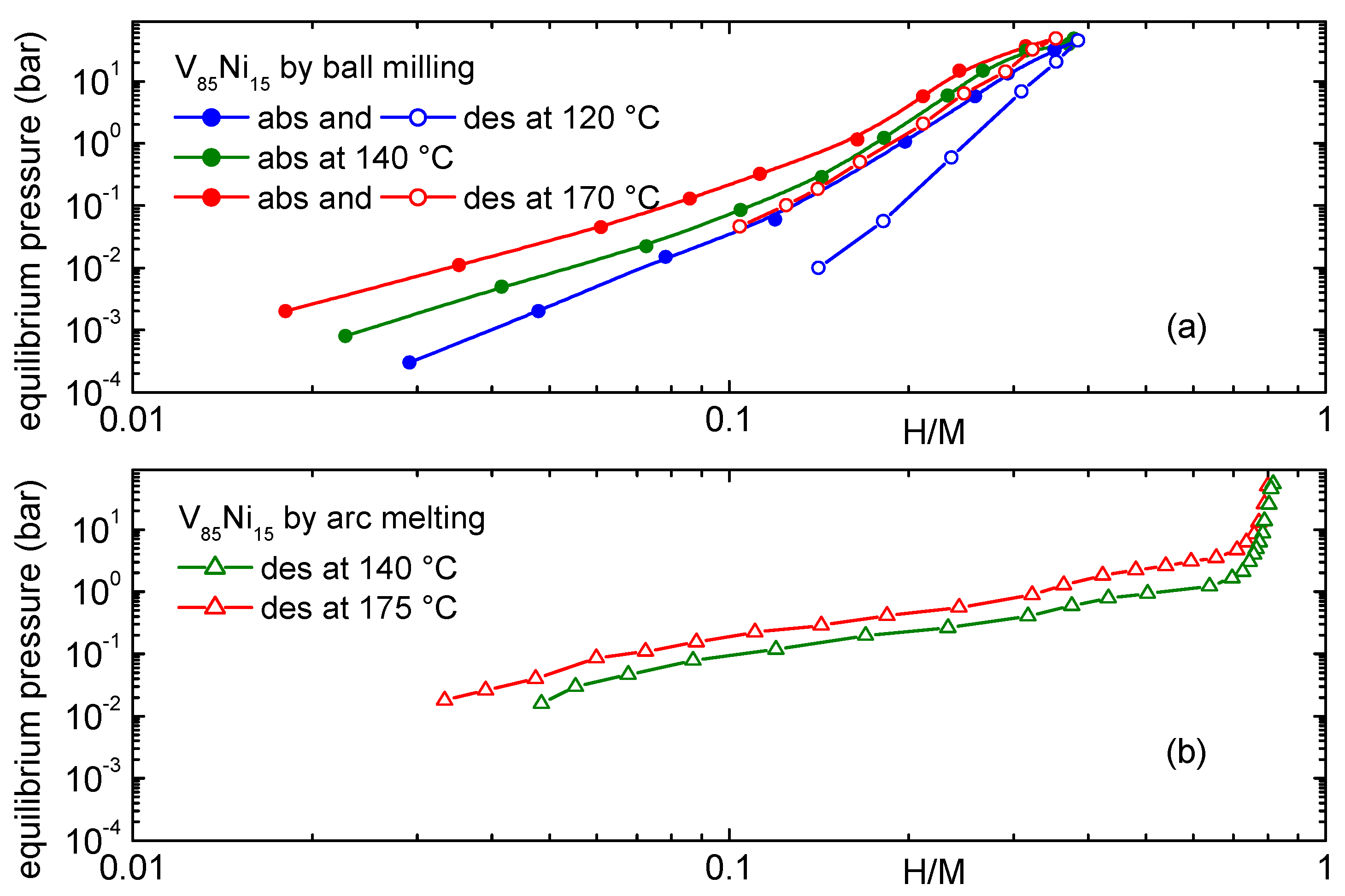
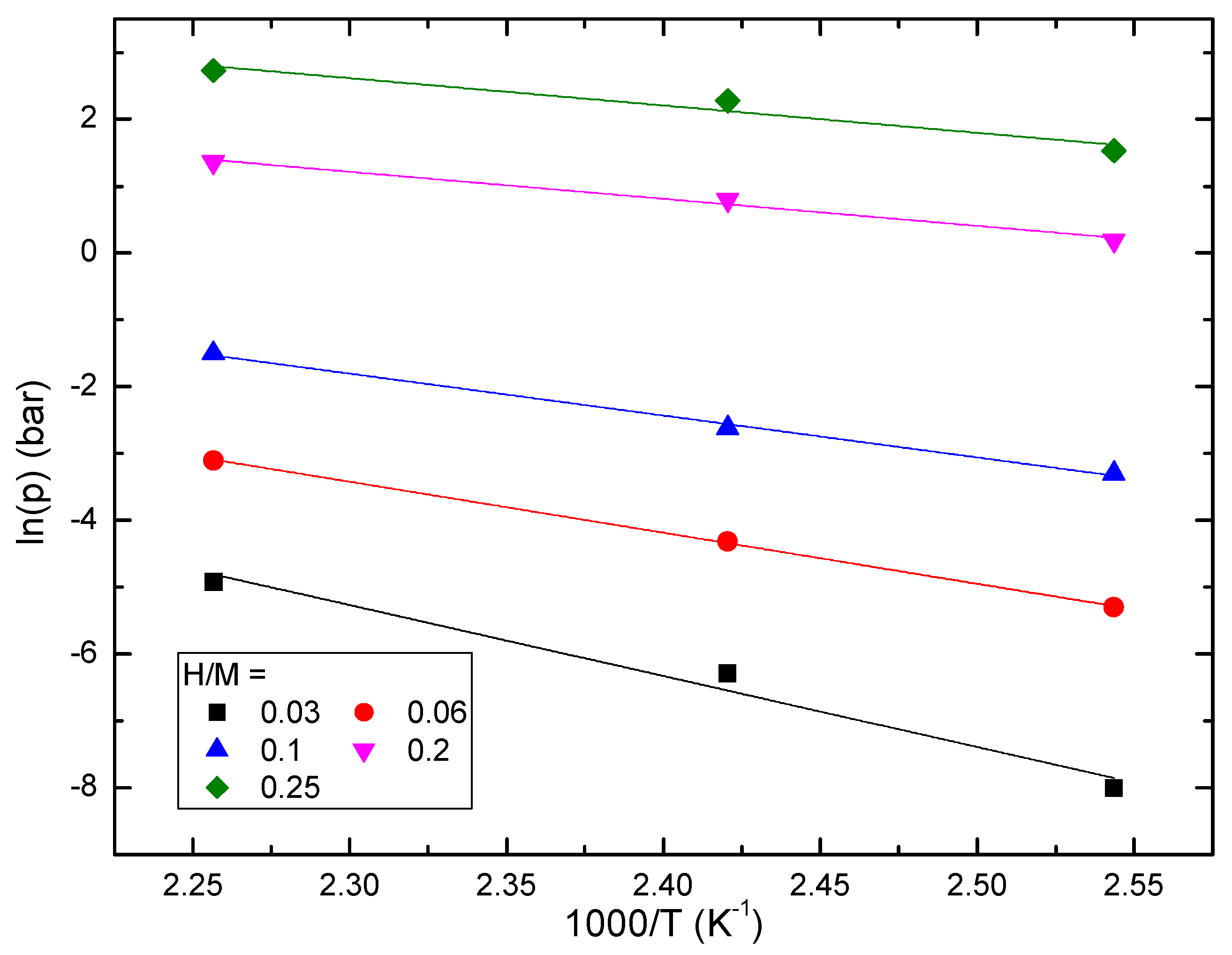
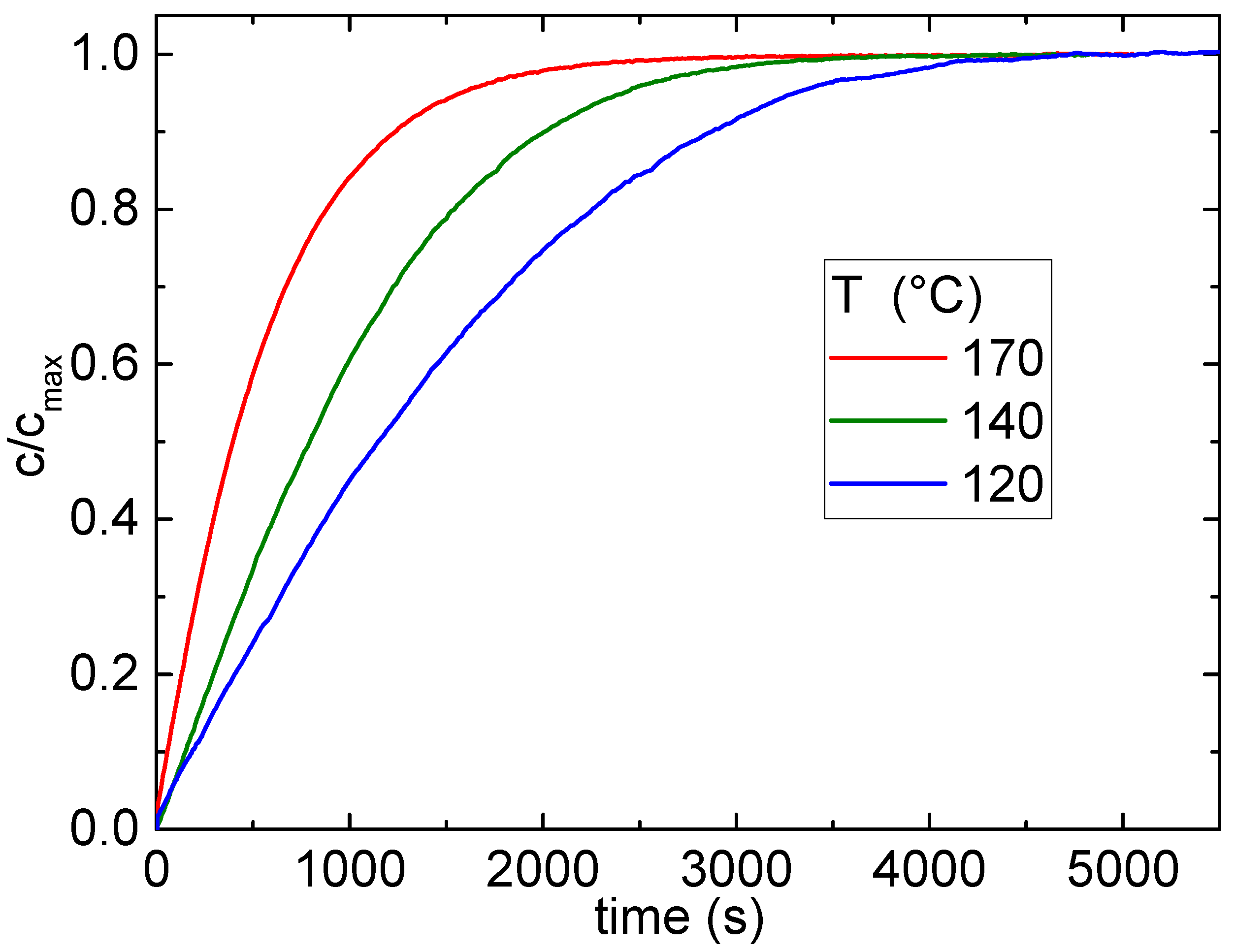
| Element | Pristine | After H2 Exchange 2 |
|---|---|---|
| V | 88 ± 5 | 87 ± 6 |
| Ni | 12 ± 5 | 13 ± 6 |
| V/Ni ratio | 7.0 | 6.6 |
| Pristine | After H2 Exchange | |
|---|---|---|
| a/Å | 2.99 ± 0.01 | 3.05 ± 0.01 |
| Size/nm | 3.3 ± 0.1 | 4.9 ± 0.1 |
| wRp | 8.6% | 8.3% |
| Gof | 1.4 | 1.5 |
| H/M | ΔHhyd (kJ/mol) | ΔShyd (J/mol K−1) |
|---|---|---|
| 0.03 | 90 ± 10 | 160 ± 30 |
| 0.06 | 63 ± 1 | 117 ± 3 |
| 0.10 | 52 ± 3 | 105 ± 7 |
| 0.20 | 33 ± 4 | 87 ± 9 |
| 0.25 | 34 ± 7 | 100 ± 20 |
Publisher’s Note: MDPI stays neutral with regard to jurisdictional claims in published maps and institutional affiliations. |
© 2022 by the authors. Licensee MDPI, Basel, Switzerland. This article is an open access article distributed under the terms and conditions of the Creative Commons Attribution (CC BY) license (https://creativecommons.org/licenses/by/4.0/).
Share and Cite
Palumbo, O.; Carboni, N.; Trequattrini, F.; Brutti, S.; Paolone, A. Mechanochemical Synthesis and Hydrogen Sorption Properties of a V-Ni Alloy. Hydrogen 2022, 3, 112-122. https://doi.org/10.3390/hydrogen3010009
Palumbo O, Carboni N, Trequattrini F, Brutti S, Paolone A. Mechanochemical Synthesis and Hydrogen Sorption Properties of a V-Ni Alloy. Hydrogen. 2022; 3(1):112-122. https://doi.org/10.3390/hydrogen3010009
Chicago/Turabian StylePalumbo, Oriele, Nicholas Carboni, Francesco Trequattrini, Sergio Brutti, and Annalisa Paolone. 2022. "Mechanochemical Synthesis and Hydrogen Sorption Properties of a V-Ni Alloy" Hydrogen 3, no. 1: 112-122. https://doi.org/10.3390/hydrogen3010009
APA StylePalumbo, O., Carboni, N., Trequattrini, F., Brutti, S., & Paolone, A. (2022). Mechanochemical Synthesis and Hydrogen Sorption Properties of a V-Ni Alloy. Hydrogen, 3(1), 112-122. https://doi.org/10.3390/hydrogen3010009









